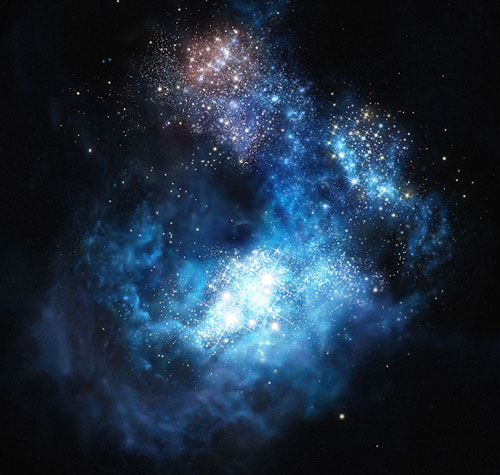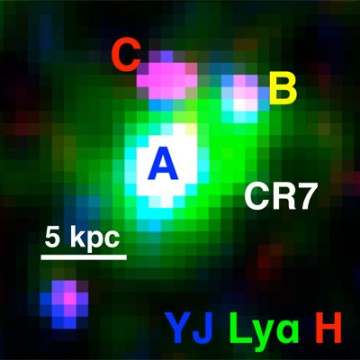Astronomers have come upon the tantalizing signal from some of the universe’s first stars.

The early universe was vastly different from the one we experience today. The elements we’re familiar with from everyday life didn’t exist — there was no carbon, no oxygen, no silicon. Instead, simple hydrogen and helium pervaded the primordial darkness, along with trace amounts of lithium and beryllium.
The first stars were vastly different too, born more than 13 billion years ago into swirling clouds of dark matter and pristine gas. With no heavier elements to cool collapsing gas clumps, the first generation of stars, known to astronomers as Population III stars, would have grown to giant size (at least 60 and maybe up to 300 times the mass of the Sun) before they could turn on fusion in their cores. They would have been responsible for churning out the heavier elements that shaped the evolution of second-generation stars and the galaxies they lived in, and they might even have ended their lives in furious explosions.
But until now, this first, vital generation of stars has been largely hypothetical. Now David Sobral (University of Lisbon, Portugal, and Leiden Observatory, The Netherlands) and colleagues have reported in the Astrophysical Journal a never-before-seen glimpse into first-generation star formation.
Finding the First Stars

The discovery came as part of a larger survey conducted with the Subaru telescope on Mauna Kea, which picked out faraway galaxies by their Lyman-alpha lines, a spectral line associated with ionized hydrogen. The universe’s expansion has stretched these galaxies’ ultraviolet spectral line into Subaru’s near-infrared range.
Sobral’s team followed up on two of the brightest Lyman-alpha-emitting galaxies, dubbed MASOSA and CR7, observing them with the Very Large Telescope in Chile and the Keck II telescope in Hawai‘i. The spectrum of CR7, which spanned from near-infrared to ultraviolet wavelengths, showed exactly two emission lines: the Lyman-alpha line from ionized hydrogen and another emission line from ionized helium.
“If this is Population III star formation, then that is very exciting,” says Jonathan Tan (University of Florida). “It would be the first example of such a process.”
Cautionary Tales
But, Tan cautions, though the detection of the helium spectral lines is strong enough, he’s not convinced it points exclusively to first-generation stars. He thinks second-generation stars, albeit ones really poor in heavier elements, might also be able to produce the observed signal.
Even if these stars really are unpolluted, first-generation stars, follow-up Hubble Space Telescope images show that they are not alone. Two red clumps of second-generation stars lie 16,000-some light-years away from the bluer clump at the galaxy’s center. The red clumps irradiate the blue clump, altering its star-formation chemistry.
It’s not yet clear why one part of the galaxy would already be on the second generation of star formation while another part is just getting started on the first. It could be that we are witnessing a wave of star formation sweep over the galaxy. But in any case, the presence of other stars means that any first stars within the blue clump aren’t quite the first generation.
The Holy Grail
The real holy grail in this field, Tan says, is to find those stars born in true primordial darkness, free not just from the pollution of heavier elements but from light itself. “The James Webb Space Telescope is probably needed for this,” he adds, “and even then, I’m not certain it will be able to do it.”
Learn more about the first stars and other oddities in our special issue, Astronomy's 60 Greatest Mysteries.
 0
0









Comments
You must be logged in to post a comment.